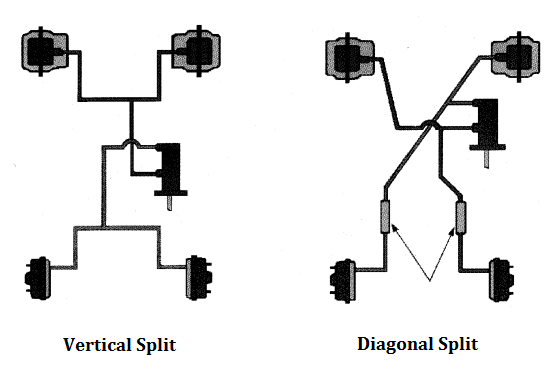Review
Front-wheel drive vehicles employ a diagonal split hydraulic brake system to provide adequate residual braking capability in the event of a partial system failure. Since brake capability is directly proportional to the weight being carried by those wheels during braking, it becomes evident that a front wheel drive with an 80% front, 20% rear weight distribution would have unacceptable residual braking should the front system fail using a conventional front/rear split. With a diagonal split, should a partial system failure occur, 50% residual braking capability would still be available because one front and one rear wheel would still be operative, remembering that the braking capability is directly proportional to the weight carried per wheel.
Master Cylinders
1. A number of tandem master cylinders are fitted to locally produced front-wheel drive vehicles. The early type being the PBR Fast Fill master cylinder with dual built in proportioning valves and pressure differential warning switch. Versions of these were fitted to Ford Telstar, Nissan Pulsar and Mitsubishi Colt. While early Mitsubishi colt and Holden Camira used versions without the Fast Fill feature.
2. The PBR A.D.R. master cylinder was modified to incorporate dual proportioning valves, and have been fitted to Toyota Corolla since its change to the front wheel drive. Another version of the A.D.R. master cylinder incorporating dual proportioning valves and Fast Fill is fitted to Mitsubishi Magna. Until late 1993, Toyota Camry utilised a PBR tandem master cylinder with the fluid indicator, not pressure differential warning switch or inbuilt proportioning valves.
3. Ford Laser, Capri and later model Camiras and Pulsars used an ultra compact cross split with proportioning valves and a Fast Fill master cylinder. A Fast Fill or quick take up master cylinder has a large diameter filling stage and a smaller diameter pressure stage. A special relieving ball valve is fitted to the master cylinder reservoir feed port.
The Advantages of Fast Fill
The Advantages of a Fast Fill Master Cylinder are to provide accelerated application by rapidly bringing the pads into contact with discs and providing higher output pressures due to the smaller diameter of the pressure piston.
Bleeding the Hydraulic System
Brake bleeding is necessary when the air has entered the brake system due to any reason or when replacing the brake fluid at the recommended fluid interval changes. Four common methods of brake bleeding are:
- Pressure bleeding – It requires a special pressure bleeder.
- Vacuum bleeding – It requires a special vacuum bleeder.
- Manual bleeding – It requires an assistant.
- Gravity bleeding –It requires time and attention.
All methods should commence by bleeding the secondary system first, commencing with the rear wheel brake and diagonally opposite front wheel brake. The secondary section system is that which is connected to the section of the master cylinder nearest the front of the car. This is then followed by bleeding the rear wheel brake connected to the primary section system, followed by the diagonally opposite front wheel brake. The primary section of the master cylinder is that which is nearest to the brake booster or brake pedal. The manual method requires two people – one to pump the brake pedal, and the other to open and close the bleeder screw.
Kindly Note: A hose should always be used to drain waste fluid into a container. Appropriate safety precautions such as safety eyewear should be adhered. One person opens the bleeder screw and the other depresses the brake pedal about half the available stroke. The assistant closes the screw and the pedal is allowed to return to the off position gradually. Repeat this procedure until the fluid is free from air bubbles ensuring at all times that the reservoir does not run out of fluid. (If it does, return to the last point bled and re-bleed until fluid is free off air). In cases where the master cylinder is a fast-fill type, it is ideal to wait about 15-20 seconds between pumps, to allow master cylinder fully recuperates.
Special Attention: When the ultra compact cross split with proportioning valves Fast Fill master cylinders are bled by using the open-close method, it is essential to run the vehicle engine to keep the booster evacuated. (Care must be taken to ensure that this is carried out in a well-ventilated area). Finally, check all bleed screws are tightened securely (but do not over tighten). Wipe dry and check for leaks under pressure. Replace dust caps and top up master cylinder reservoir.



